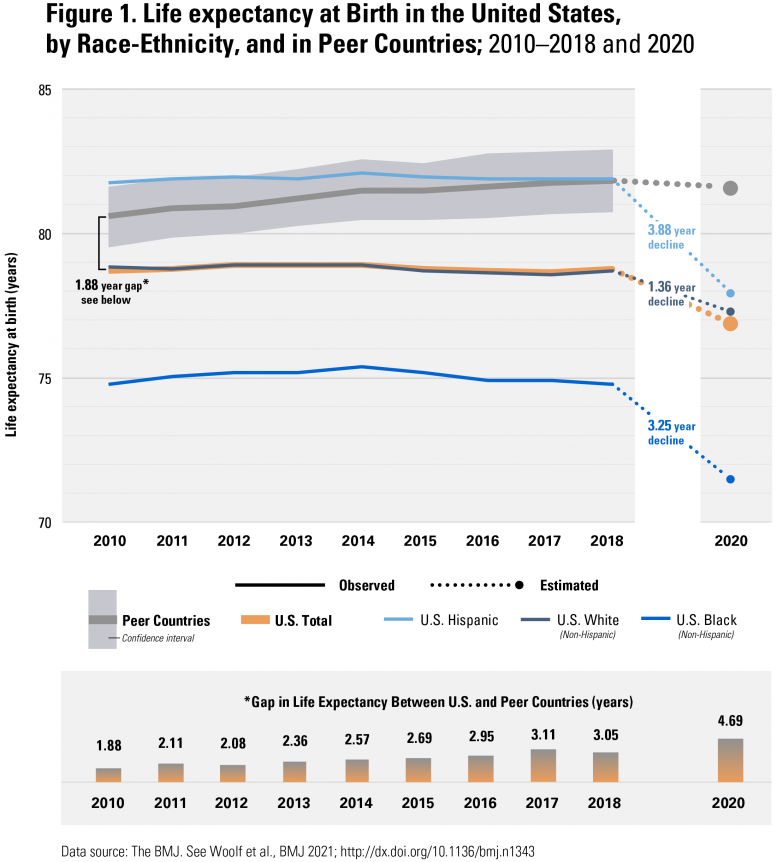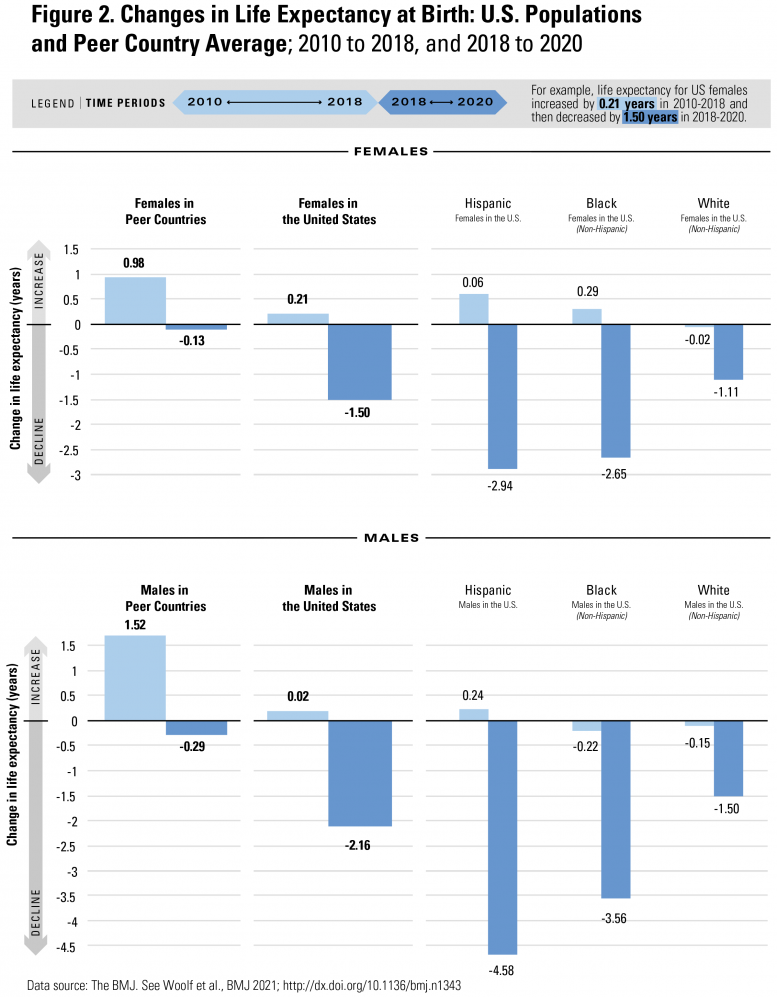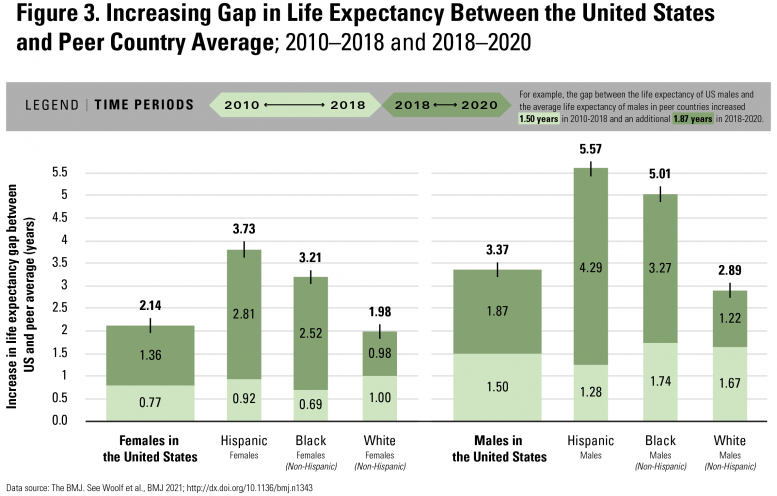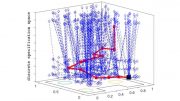
The COVID-19 pandemic has led to a “massive” decrease in U.S. life expectancy, marking the largest decrease since World War II.
COVID-19 has widened the life expectancy gap across racial groups and between the US and peer countries.
U.S. life expectancy decreased by 1.87 years between 2018 and 2020, a drop not seen since World War II, according to new research from Virginia Commonwealth University, the University of Colorado Boulder, and the Urban Institute.
The numbers are even worse for people of color. On average, whereas life expectancy among White Americans decreased by 1.36 years in 2020, it decreased by 3.25 years in Black Americans and 3.88 years in Hispanic Americans.
The data will be released today (June 23, 2021) in The BMJ, a journal published by the British Medical Association.
Other countries also saw declines in life expectancy between 2018 and 2020, but the loss of life expectancy in the U.S. was 8.5 times that of the average for 16 peer countries. The declines for minority populations were 15 to 18 times larger than other countries.

The graph in Figure 1 presents estimates of life expectancy for 2010-18 and 2020 for the U.S. and the average for 16 high-income countries. The U.S. began the decade with a 1.88-year deficit in life expectancy relative to peer countries. This gap increased over the decade, reaching 3.05 years in 2018. Between 2018 and 2020, the gap widened substantially to 4.69 years: the 1.87-year decrease in life expectancy in the U.S. was 8.5 times the average decrease in peer countries (0.22 years). Credit: VCU Center on Society and Health/The BMJ
“When the pandemic came, my naïve assumption was that it would not have a big impact on the preexisting gap between the U.S. and peer countries,” said Steven Woolf, M.D., the study’s lead author and director emeritus of VCU’s Center on Society and Health. “It was a global pandemic, and I assumed that every country would take a hit. What I did not anticipate was how badly the U.S. would fare in the pandemic and the enormous death toll that the U.S. would experience.”
The U.S. death toll has surpassed 600,000, according to Johns Hopkins University’s Coronavirus Resource Center. Excess deaths, which exceed the official count, may contribute to the impact of the pandemic, according to previous research led by Woolf.
Life expectancy trends in the U.S. were already “very worrying,” Woolf said. Since the 1980s, improvements in life expectancy in the U.S. have not kept pace with peer countries. Around 2010, life expectancy in America plateaued and then decreased for three consecutive years. It continued to climb in other countries.

Figure 2 contrasts changes in life expectancy in the US in 2010-18 and 2018-20 with those of peer countries, based on sex, and on race and ethnicity. Credit: VCU Center on Society and Health/The BMJ
“The gap has been widening for some time,” Woolf said. Then COVID-19 hit, and the United States had among the world’s highest per-capita mortality rates. Black and Hispanic communities were hit harder than White populations. Woolf’s paper is the first to show the significance of the widening life expectancy gaps. Previous reports only included data from the first half of 2020 and did not provide the comparison to peer countries.
“To give some perspective, when the decline in life expectancy was happening a few years ago, it was a decrease of about 0.1 years each year that was making front-page news,” said Woolf, VCU’s C. Kenneth and Dianne Wright Distinguished Chair in Population Health and Health Equity. “That’s the kind of increase or decrease that we’re accustomed to each year.”
Woolf called the 1.87-year decline in life expectancy “massive” by comparison.
“It’s like nothing we’ve seen since World War II,” he said. “1943 was the last time the US had such a large decrease in life expectancy.”

Figure 3 shows how changes in life expectancy contributed to the gap between the U.S. and peer countries. For example, figure 2 shows that life expectancy for U.S. women increased by 0.21 years in 2010-18, but because life expectancy in women in the peer countries increased even more (0.98 years), the gap increased by 0.77 years (figure 3). Credit: VCU Center on Society and Health/The BMJ
Six countries in the authors’ comparison group saw their life expectancy increase during 2020 — places like New Zealand, Finland and Norway. Other countries did poorly: Italy and Spain saw losses in life expectancy. But none came close to the U.S.
“The disorganized handling of the pandemic in the U.S. had a lot to do with governance,” said Woolf, a professor in the Department of Family Medicine and Population Health at VCU School of Medicine. “Our Constitution delegates public health authority to states, so we had 50 response plans. Many lives were lost because so many decisions were driven by politics and ideology. COVID-19 exposed a lot of the systemic problems that have been fueling the long-term decline in the health of Americans.
“And when vaccination gets us past the pandemic, and COVID-19 is in the rearview mirror, those systemic issues will still be with us,” Woolf said.
Included in those issues are racial health inequities and the role of systemic racism. The most jarring statistic for Woolf was the data on life expectancy for Black and Hispanic Americans. It’s well-known that COVID-19 had a disproportionate impact on people of color, but the effect on life expectancy for those groups was “jolting,” he said.
Life expectancy in Black men in particular reached its lowest level since 1998.
“It’s a big setback because, for many years, the U.S. had been making progress in closing the Black-White mortality gap,” Woolf said. “And Hispanic Americans, for many years, enjoyed higher life expectancies than Whites, but that advantage was almost completely erased by COVID-19.”
Data on Native Americans, who also experienced very high death rates during the pandemic, was not examined in the study because of inadequate data.
“In many ways, the U.S. has turned a corner in its response to COVID-19, but the data emerging on pandemic health disparities is urgent and valuable in helping understand the impact on our communities,” said Peter Buckley, M.D., dean of the VCU School of Medicine. “The life expectancy gaps between America and other countries and between racial groups reported in Dr. Woolf’s paper are worrisome, and I hope the numbers serve as a wake-up call for the health care community and beyond.”
Reference: “Effect of the covid-19 pandemic in 2020 on life expectancy across populations in the USA and other high income countries: simulations of provisional mortality data” by Steven H Woolf, Ryan K Masters and Laudan Y Aron, 24 June 2021, The BMJ.
DOI: 10.1136/bmj.n1343
Co-authors on the paper are Ryan Masters, Ph.D., assistant professor at the University of Colorado Boulder, and Laudan Aron, a senior fellow at the Urban Institute.
Woolf receives partial funding from the National Institutes of Health’s National Center for Advancing Translational Sciences, which supports the Wright Center for Clinical Translational Research where Woolf serves in a community engagement role.









Be the first to comment on "COVID-19 Pandemic Drives “Massive” Decrease in US Life Expectancy – Largest Decrease Since World War II"